In pursuit of the American Dream, immigrant cultures are reshaping New Jersey’s foodscape.
By Andy Clurfeld
From “America” by Simon & Garfunkel
Counting the cars on the New Jersey Turnpike
They’ve all come to look for America
All come to look for America
All come to look for America
Drive the Turnpike in 2018, 50 years after “America” was released by the poet-rocker duo, and you’ll find today’s America at every exit. Its sister thoroughfare, the Garden State Parkway, offers the same people-scape at every exit ramp as well. Cross-hatch the ’Pike and the Parkway with major roadways such as Interstate 80, 195 and the Atlantic City Expressway, and you’ll find jump-off points that lead to people, places and things of incredibly diverse origins.

NetCost
Is New Jersey America’s most emblematic state? Could this Mid-Atlantic stalwart of the original Colonies, gateway to the Northeast, subject of Mason-Dixon Line debates and most teased member of the family of states united under a red, white and blue flag signifying liberty and justice for all be the poster child for America itself?
The argument could be made.
It would be won, slam-dunk, on the merits of our peerlessly diverse and delicious foodways. I’ve taken to saying, as I’ve worked the past year to form the Garden State Culinary Arts Foundation, that New Jersey—a peninsula of 8.9 million people bordered by two major rivers, a connective ocean and the unique and fertile Delaware Bay—is singularly positioned as the nation’s culinary leader.

Gourmanoff
For not only does it benefit from those waters, but from a wide-ranging geology that allows for the cultivation of many and myriad crops and provides lands for raising animals. Somehow, in a state that balances extreme densities of populations in its cities with expanses of space in its countrysides with veritable crops of varying housing types in its suburbs, we’ve also become one of the most diverse states in America. Our ethnic communities have taken root in cities, in rural areas, in the suburbs.
No matter the roadway, no matter the exit, you’ll find foods that define the now-wide-breadth of today’s cuisine in America.
It started in New Jersey with waves of immigrants from Italy, Ireland,

HMart
India, Germany, Cuba, and Puerto Rico. Ellis Island—whose 27.5 acres were found by the U.S. Supreme Court in 1998 to be dominated by New Jersey —was the gateway for these folks, who settled in Garden State cities, farmed its lands north, central and south, and set up shops everywhere to make Old World staples and invent hybrid foods that used New World ingredients in recipes developed back home.

DMart
The next waves of immigrants, from Mexico, the Philippines, Poland, Korea, Peru, the Dominican Republic, Colombia, Ecuador, Portugal and other parts of India, formed enclaves throughout the state and brought with them their culinary traditions that added to the increasingly rich foodscape.

Food Bazaar
Foreign-born populations in Hudson, Middlesex, Bergen, Union and Passaic counties began serving forth in restaurants and specialty markets foods you’d once needed a passport to experience. From Ducktown, an Italian enclave in Atlantic City, to the Koreatowns of Palisades Park and Fort Lee; from the Ironbound’s Portuguese community of Newark to Havana on the Hudson in West New York and Union City; from India Square in Jersey City and Little India in Edison/Iselin to the Little Istanbul, Little Lima, Little Bangladesh and the huge number of various Little Middle Easterns in Paterson, there’s a world of authentic cuisines in New Jersey.
Travel to the ‘burbs outside Atlantic City, and you’ll find expert Vietnamese food. There’s more in Cherry Hill and on the outskirts of Camden. Filipino fare is flush in Jersey City’s Little Manila and also in Bergenfield, Piscataway, Edison, Belleville, and Woodbridge. Scout Mexican in Long Branch, Freehold, New Brunswick, Trenton, Vineland, Bridgeton, Lakewood, and Red Bank. Don’t expect to visit South Paterson without spending a day devouring Turkish foods.

Mitsuwa
What’s more American than a bountiful table with an equally bountiful number of options? Our food choices in New Jersey, thanks to the various waters we have for fishing, the wide range of soils we have to cultivate and grow crops and raise animals for meat and dairy, and the globe-spanning backgrounds of our population who bring a world of edibles right to our doors, are second to none.
Second to none.
I see that as I shop in Mitsuwa, the Japanese uber-market in Edgewater with not only a peerless selection of fresh and prepared foods but also with a food court that puts to shame anything you’ve experienced in a major mall.

Chowpatty
I see, as well, that we indeed are second to none when I scour the shelves at NetCost, the Russian/Eastern European supermarket in Manalapan or its sister, Gourmanoff, in Paramus. There’s an increasing number of Hmarts in the Garden State, a testament, yes, to the Korean populations but also to the interest folks of all ethnicities have in Korean cuisine and ingredients. Food Bazaar (I like the one in West New York) is where you can find Latin-leaning ingredients, and Jersey City’s India Square is home to a host of markets, including D-Mart. I’m also a fan of Chowpatty’s small snacks-and-sweets shop in Iselin.
If you want to look for America today, start here at home, in New Jersey. Because we are both the original melting pot and the modern melting pot, convening in our compact state at the biggest table the world has ever known.
Bon appetit!
Editor’s Note: The 2018 Garden State Culinary Arts Awards took place in April. Among the winners were Razza Pizza Artigianale’s Dan Richer (Outstanding Chef), who was profiled in a past issue of EDGE, and Ariane Daguin (Culinary Legend) of D’Artagnan in Union.
An American Returns to Vietnam
By Rick Geffken
I think it happened when Ken Burns and I spoke during the promotional tour for his 18-hour documentary film series, The Vietnam War. The conversation was part of a confluence of happenstances that seemed to be pulling me back to a place whose mere mention still conjures agony, anger, and guilt in those of us who lived through that disastrous period of American history. It felt like the final sign, or permission perhaps, to return to the country where I’d spent the 16 most hazardous months of my life.
And to search for the beautiful South Vietnamese woman who had once been my fiancée.
That was then. In December 2017, walking among Hanoi’s street vendors and busking musicians, I was just a tourist, not a whole lot different from the ubiquitous backpackers drawn to the capital city by its cheap lodgings and myriad diversions. I indulged in street foods, seated at the tiny plastic tables the proprietors set up beside their charcoal grills. The barbequed chicken or pork called bun cha, and ban me, the baguette sandwiches slathered with margarine and paté. Both are served with tangy nuoc mam, the fish sauce I could never get enough of. The shops are everywhere, especially the local Highlands Coffee chain. I developed a nightly addiction for the espresso-like Vietnamese coffee flavored with a thick condensed milk. Each cup comes with a small metal drip filter, not designed for the impatient.
 Making my way from a coffee shop to the Ho Chi Minh Mausoleum is as jarring as it gets for an American war veteran. Not too far away is a monument to John McCain’s seizure at Truch Bac Lake (left), commemorating where he parachuted after being shot down in 1967. Equally disconcerting was passing through the doors of Hoa Lo Prison (aka the Hanoi Hilton), where captured soldiers and airmen were subjected to deprivation and torture. American POWs had more prescient gallows humor than they knew. The twenty-five-story Hanoi Towers overshadows the infamous prison these days. The day I visited Hanoi’s university, the Temple of Literature, built in 1076, I watched proud parents taking pictures of recent grads with their diplomas. They were happy to pose with me, too.
Making my way from a coffee shop to the Ho Chi Minh Mausoleum is as jarring as it gets for an American war veteran. Not too far away is a monument to John McCain’s seizure at Truch Bac Lake (left), commemorating where he parachuted after being shot down in 1967. Equally disconcerting was passing through the doors of Hoa Lo Prison (aka the Hanoi Hilton), where captured soldiers and airmen were subjected to deprivation and torture. American POWs had more prescient gallows humor than they knew. The twenty-five-story Hanoi Towers overshadows the infamous prison these days. The day I visited Hanoi’s university, the Temple of Literature, built in 1076, I watched proud parents taking pictures of recent grads with their diplomas. They were happy to pose with me, too.
 Hanoi was only one stop on my three-week odyssey. In South Vietnam, my friends and I idled a few days in the seaside resort of Vung Tau, called Cap Saint-Jacques by the French. Gorgeous mountain lookouts and theme parks feature huge statues: the Buddha atop one and Jesus another. Our B&B was opposite a wonderful seafood restaurant, where we dined among what looked like members of Vietnamese high society celebrating Christmas. In Ho Chi Minh City (formerly Saigon), Christmas carols blasted day and night from commercial malls and government offices everywhere in the Communist metropolis. Gift-wrapped packages were stacked in store windows, hotel clerks wore red Santa Claus hats, and Christmas trees were decorated with bright lights and outsized ornaments. The incongruity of it all suggested we may have lost the military conflict, but we won the cultural war. The Vietnamese may have to decide one day if that’s a good thing
Hanoi was only one stop on my three-week odyssey. In South Vietnam, my friends and I idled a few days in the seaside resort of Vung Tau, called Cap Saint-Jacques by the French. Gorgeous mountain lookouts and theme parks feature huge statues: the Buddha atop one and Jesus another. Our B&B was opposite a wonderful seafood restaurant, where we dined among what looked like members of Vietnamese high society celebrating Christmas. In Ho Chi Minh City (formerly Saigon), Christmas carols blasted day and night from commercial malls and government offices everywhere in the Communist metropolis. Gift-wrapped packages were stacked in store windows, hotel clerks wore red Santa Claus hats, and Christmas trees were decorated with bright lights and outsized ornaments. The incongruity of it all suggested we may have lost the military conflict, but we won the cultural war. The Vietnamese may have to decide one day if that’s a good thing
Regardless of where I traveled, it was difficult to find evidence of our war anymore. The Citadel in Hue, the old imperial capital of Vietnam, and the scene of ferocious fighting during Tet in 1968, has been restored. The small civilian homes once sheltered by its thick walls and moats were not rebuilt. The Imperial Enclosure and the Forbidden Purple City were—and they once again honor the Nguyen Dynasty, Vietnam’s last. I purchased delicate painted paper lanterns at the gift shop near where so many men from both sides fought and died. On the wide boulevards of Ho Chi Minh City, I saw little of the old French colonial Saigon, with its distinctive Parisian feeling, that I remembered. Millions of motorbikes now zoom past modern electronic chain stores, western-style gyms and yoga studios, and tall office buildings. Luxury high-rise condominiums line the Saigon River in the incongruously named “Diamond City.” Classic old buildings are being taken down and replaced with shiny new skyscrapers, as the city rushes toward world-class city status.
Two reminders of the American War, as the Vietnamese rightly call it, do exist.
The Presidential Palace, where a succession of South Vietnamese dictators lived, is now the Reunification Palace. The War Remnants Museum (above) won’t let visitors forget atrocities like Agent Orange and napalm. It’s filled with captured American weapons, tanks, planes, and unforgettable images of victims of brutality, both civilian and military.
 In 1969, as a young Army lieutenant, I flew along the Cambodian border in a Birddog observation plane, spending my days looking for North Vietnamese troops. The bomb-cratered landscape I surveilled resembled the moon Neil Armstrong stepped onto that same year. Occasionally, what sounded like the intermittent buzzing of mosquitos around our plane drew my attention to muzzle flashes from shooters a thousand feet below. As quickly as they appeared, they skedaddled into their hidey-holes on the side of the border we weren’t supposed to cross. Being a target of small arms fire will instantly snap you out of revaries contemplating the natural scenic beauty of Vietnam. And out of the remorse for what a large country can do to destroy a small one.
In 1969, as a young Army lieutenant, I flew along the Cambodian border in a Birddog observation plane, spending my days looking for North Vietnamese troops. The bomb-cratered landscape I surveilled resembled the moon Neil Armstrong stepped onto that same year. Occasionally, what sounded like the intermittent buzzing of mosquitos around our plane drew my attention to muzzle flashes from shooters a thousand feet below. As quickly as they appeared, they skedaddled into their hidey-holes on the side of the border we weren’t supposed to cross. Being a target of small arms fire will instantly snap you out of revaries contemplating the natural scenic beauty of Vietnam. And out of the remorse for what a large country can do to destroy a small one.
I came face-to-face with beauty when I met Le Thi Nga, one of the interpreters at the 25th Infantry Division’s Military Intelligence Detachment in Cu Chi. As did most young Vietnamese women, she wore the traditional ao dai (pronounced “ow-zai”), the flowing and tight-fitting colorful silk tunic worn over long black trousers. We spent hours together almost every day. Eventually, we began exchanging dreams for a shared future as we tried to bridge the cultural gaps between us. When I discovered that she, like me, was Catholic, I was convinced we were fated to fall in love.
Her parents weren’t so sure, despite my efforts to impress them by attending Sunday Mass at their small church in Bac Ha village. Not only was I the sole uniformed American in the congregation, the M-16 rifle propped on my kneeler could not have helped them envision a traditional marriage for their daughter. By the time my tour was over, Nga and I decided it was best for us to lead separate lives in very different societies.
Fast-forward nearly five decades. I hired a driver to take me from what I still thought of as “Saigon” to Bac Ha. It had been 20 years since I last heard from Nga in a letter describing an abusive marriage and divorce from a former South Vietnamese soldier. The only clue I had to her whereabouts was an old return address. I had no idea if she was still alive. My driver’s English was passable enough to understand where I wanted to begin my search. We left the puttering motor scooters of Saigon’s chaotic traffic for the journey northwest. The old dirt road I traveled many times once bordered rice paddies with working water buffalos and a few mud huts with thatch roofs. These days, it’s a bustling major highway lined with shops, small restaurants, and not a few large factory buildings.
My first stop was the small village church, my best guess being that the local priest might assist me in locating Nga. The rudimentary house of worship was now a larger, more modern church, apparently serving a prosperous community of believers. Unfortunately, I arrived on a day when no worshipers were around. Near the door of the locked church, the name “Le Thi Nga” appeared on a list of contributors. If this was indeed my Nga, it meant she was still living close by.
A cleaning woman seemed to recognize Nga’s name on my old letter but motioned that she had moved away to Cu Chi town some time ago. This was not good news. It meant my search would be more complicated because I’d have no starting point in a city far different, unrecognizable really, from the little town I’d frequented for drinks, food, and other wartime comforts. Next, we stopped an old man on a motorbike. He recognized Nga’s name. His translated response was “Is she a lady around 60 years old?” Yes, I said, and he agreed to show us to her home. Were we talking about the same woman?
Our guide led us back to the main road, a divided highway with modern buildings on both sides. It had been dirty and dusty all those years ago, crowded with small restaurants, make-shift laundries, the poor hovels of the men and women who supported our base, and houses of ill repute. The workers were herded through our base security gates each morning to our hootches, where they washed and ironed our fatigues, and cleaned our latrines, burning the half-cut 55-gallon drums of GI excrement with the unforgettable smell of burning diesel fuel. This is as familiar a flashback to veterans as the whoosh-whoosh of Huey chopper blades. Our scooter man pointed for us to park on a side street while he rode off down the sidewalk. Returning within minutes, he motioned for me to hop on the back of his scooter, and off we went, past astonished pedestrians. Near a yogurt and juice store, he gestured toward a side door where he had just told the owner that someone was looking for her.
Tentatively, I made my way down a dimly lit corridor.
“Nga?” I called out. “It’s Rick.”
I heard footsteps approaching and recognized her immediately despite her look of astonishment. Tears began pouring down her cheeks. We embraced, speechless.
“How did you find me? What are you doing here? Why didn’t you write ahead?” she finally stammered in little-used English.
“I wanted to surprise you,” I responded, though in truth I had no idea I’d actually locate her.
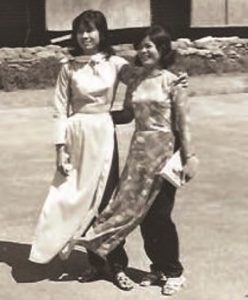 Nga motioned for me to sit. She kept leaving the small kitchen area to compose herself and catch her breath. She said something about me being like a detective to find her, still in shock until she finally settled beside me. I’d brought along some old pictures. Our great friend Hung, her best friend Lan (above left), and my fellow lieutenants: Fly, Sam, and Jim. We lingered over the images of parties at her house. Ba Muoi Ba beer bottles littered tables filled with spring rolls, pho, and other delicacies—my first introductions to what is now world-famous cuisine. What news of Lan? I was distressed to learn she was “sick now,” living with her family just a few houses down the street. Of course, I wanted to visit her.
Nga motioned for me to sit. She kept leaving the small kitchen area to compose herself and catch her breath. She said something about me being like a detective to find her, still in shock until she finally settled beside me. I’d brought along some old pictures. Our great friend Hung, her best friend Lan (above left), and my fellow lieutenants: Fly, Sam, and Jim. We lingered over the images of parties at her house. Ba Muoi Ba beer bottles littered tables filled with spring rolls, pho, and other delicacies—my first introductions to what is now world-famous cuisine. What news of Lan? I was distressed to learn she was “sick now,” living with her family just a few houses down the street. Of course, I wanted to visit her.
As we entered the open-front fabric and ribbon store, I knew the young proprietress was Lan’s daughter even before we were introduced. Uyen had the same fine features as her mother. She and Nga retreated to a back room, asking me to join them a few moments later. I removed my shoes before entering the living room. And there, lying on a bed in a semi-comatose state was our beautiful Lan, very thin and reduced now to breathing through an oxygen tube. Her gray hair was shaved close, no longer the flowing black mane that once framed that exquisite face. Did I hide my shock well enough? I was embarrassed to be in this intimate family place, a virtual hospital room for a gravely ill woman. No explanation of her illness was offered.
Lan could no longer communicate, but Nga and Uyen spoke to her anyway.
“Rick has returned to see you.”
I bent down to kiss an inert Lan, whispering I loved her and how I appreciated her kindnesses when we first knew each other. This strong, intelligent woman who once wrote me letters of friendship, to help me understand the language, was dying. Lan’s husband emerged from the back of his home. Shirtless in the Vietnamese climate, Nguyen Hoa greeted me with affectionate gestures as Nga explained who this stranger was in his home. I gave him some pictures of a young Lan and a copy of a New Year’s greeting she wrote to me before they were married. He reciprocated by showing me his picture as a proud uniformed man, and those of his ancestors enshrined on an altar-like bureau in the living room.
Uyen’s brother, Khoi, clearly his mother’s son, entered and offered a shy hello. We stepped outside the family home to take pictures. Uyen said, “My family and I would like to thank you for your visiting. My mother must be very happy. We wish you healthy and happiness.”
The American War is little more than faded history for the newest generation.
The Vietnamese are a most gracious people, unfailingly polite, kind and self-effacing. In as much of that spirit as I could muster, I took Nga to lunch. At the large outdoor restaurant she ordered egg rolls, deep-fried eel and herb salad makings. Fifty years vanished as she carefully assembled spring rolls on thin rice paper and reminded me to dip them into nuoc mam, peanut sauce, or soy. She laughed as she let me kiss her for the photo in the empty restaurant. “I am single, I don’t care!”
Returning to her home, we exchanged small talk in the car’s back seat, my hand resting gently on her knee, a gesture more of friendship than intimacy. “I am very happy today,” she repeated a number of times. We walked down the narrow village streets toward her old house, where she once invited our friends for fun and diversion. She insisted I wear a nón lá, the Vietnamese conical hat, to protect me from the midday sun. Her humor was still intact as I took our selfie: We looked like “two VC’s,” she said, referring to the Viet Cong guerillas thereabouts the last time we were together. This very odd couple strolling side-by-side drew bemused glances from the windows of the modern homes that replaced the old thatch-roofed huts. Following the death of her parents in the early 1980’s, Nga sold the house. It was torn down, two new homes on its site. “I loved my old house here,” she said. I did, too. Two old friends spoke of the past and the reasons they didn’t marry. Nga’s her mother “cried and cried” at the prospect of her only daughter’s leaving. My intuition was that my America might be an overwhelming place for a country girl. I sensed no current disappointment in those decisions, just a reluctant realization of hurdles too high to jump.
After 1975 and the fall of the South Vietnamese government, Nga and others who had worked for the Americans had their ID papers specially marked. She was sent to the fallen Saigon for a two-week re-education class—a far milder punishment than other South Vietnamese “collaborators” experienced. Still, she recalled, “it was very hard.” Later, Nga was assigned to work in a tourism office in Vung Tau for five years. She was married and divorced with no children, and has been single for decades. Nga reported that there are no government soldiers around now. Just “too many police…but they leave me alone.”
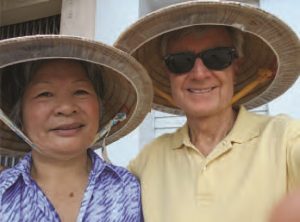 Nga and I held time at bay for several hours, though not quite turning back the clock. Familiarity returned; romance less so. I realize now that a lonely soldier confused warm companionship and a dollop of guilt with true love. I won’t diminish what Nga and I had during the war. Had I brought her home to America, there’s an even chance we might have grown to love each other enough for a marriage to prosper and thrive. And just as likely she might have become homesick and discontented with a fast-paced and rapidly changing society so different from her traditional life in Vietnam. The exigencies of fate won’t allow a resolve to these hypotheticals.
Nga and I held time at bay for several hours, though not quite turning back the clock. Familiarity returned; romance less so. I realize now that a lonely soldier confused warm companionship and a dollop of guilt with true love. I won’t diminish what Nga and I had during the war. Had I brought her home to America, there’s an even chance we might have grown to love each other enough for a marriage to prosper and thrive. And just as likely she might have become homesick and discontented with a fast-paced and rapidly changing society so different from her traditional life in Vietnam. The exigencies of fate won’t allow a resolve to these hypotheticals.
Everyone in town seemed to know and respect Nga. She still walks briskly with the same dignity I recalled, head held high. She’s slim-figured with less gray hair than me. All in all, she’s made it through the years nicely.
Old friends walked back to my car on a bright and hot afternoon, having said all we could. On a busy Bac Ha street, I asked if I could kiss her good-bye, intuitively knowing her demurral wouldn’t be a rejection. No, it would simply not be proper for a single Vietnamese woman to display public affection. Even to an aging foreign man returning to her a lifetime later.
How a dream renovation became a nightmare… and how you can keep it from happening to you.
By Mark Stewart
No home renovation project goes exactly as planned, regardless of how meticulously you’ve planned in advance. Deep down, most homeowners understand this. However, when a “home reno” jumps the tracks, it produces the kind of gnawing, roiling anger that can throw your entire life out of whack. I speak from experience. Last summer, with the kids out of college, out of the house and out in the world being solid (and self-sufficient) citizens, we decided to pop for an entirely new kitchen.
The time was right. Although we had inherited a perfectly functional kitchen from a previous owner, it was what my wife liked to call “dated” the day we moved in. Two decades later, as the cupboard doors were falling off their hinges, she usually inserted an expletive in front of “dated.” Those hinges, by the way, were stamped Made in West Germany, so yeah, they were [expletive] dated. The upside of waiting so long was that we completely agreed on the optimal layout. We knew what we needed and didn’t need, and set a budget that reflected all of these sensible choices

www.istockphoto.com
The final bill was about $40,000, which is about what we budgeted. There was a fair amount of custom work and carpentry involved, but it’s not a huge space so we thought the price was reasonable. The cabinets and countertops were first-rate and we could not have been happier with the results. My wife really put a lot of research and legwork into these choices and was unflustered when the stone place sold our first counters out from under us by mistake. She didn’t even freak out when our kitchen contractor failed to count the number of cabinets until a couple of weeks after they had been delivered, only to find out that the manufacturer had forgotten to build one.

www.istockphoto.com
Less than 10 percent of our budget was dedicated to flooring. As luck would have it, flooring turned out to be 100 percent of the problem. We picked an installer who had an impeccable reputation. It was a family business that had been around for decades. The beloved father had given way to his daughter, who exuded the class and confidence you like to see in these situations. Her salesman came to the house and suggested a high-tech linoleum product that would give us the unusual floor design we wanted. It sounds icky, I know, but it was really cool (and not inexpensive).
We live in a century-old house on the side of a hill, so nothing is exactly straight. The kitchen floor has a bend to it that reflects 100-plus years of settling. The previous owner, a roofing company executive whom we knew to be meticulous, had solved this problem when he re-did the kitchen during the Bush I administration. The cabinets may have been disintegrating in 2017, but the floor looked as good as the day it went in. We just weren’t crazy about the look. As the salesman assured us that we had made a brilliant choice, I began to question whether he was thinking in two dimensions or three. Or whether he just said Yes to anything, collected his commission and then dumped the job on the workmen. No, he responded, this is a “floating” floor, so with some leveling in a couple of spots, it is actually an ideal choice.

www.istockphoto.com
The renovation timeline, from demolition to completion, was four weeks. We aren’t stupid. We knew it would take longer. But our contractor and his carpentry crew, who did exceptional work, kept telling us this was a relatively simple, straightforward job. So of course, 24 hours after the flooring was installed, we knew something wasn’t quite right. In several places, the seams that were supposed to fit snugly together were curling upward to such a degree that you could almost trip on them. Needless to say, the cabinets couldn’t go in until this issue was addressed. Despite several conversations with the owner of the flooring company, she did not send anyone to look at the problem, nor did she make the 20-minute drive from her office to our house to evaluate the problem for herself—for more than six weeks from the day we first alerted her that something was obviously wrong.
As anyone who has lived through a kitchen reno knows, there is no part of your family routine that isn’t completely disrupted during construction. We had a second refrigerator in the basement, which was great, but our only cooking appliances were a toaster and a microwave, which we moved into the library. (Full disclosure, the “library” isn’t as fancy as it sounds—it’s a room with two bookshelves and we couldn’t think of a better name for it). Meanwhile, a fine layer of dust settled on everything we owned.
Finally, the flooring company owner showed up. She rattled off a series of theories and excuses for why the material failed. Most of them sounded like they were our fault or the fault of someone who no longer worked for her. We countered each with the same question: Why didn’t you come the day after we told you there was a problem? Her answer was that she had worked with this product for years and never had a problem. As the words crossed her lips, I could tell she wanted them all back. If that was the case, then you should have been here an hour after we called, not six weeks later. She sent in a crew to fix the problem but it was really too late
The cabinets had been installed around the trouble spots in the flooring, and within a few weeks of their “fix” the seams began to separate. There is no way to fix this and there is no way they will ever see the balance of the invoice they sent me after they walked out the door (without so much as an apology).
This was not our first brush with an unprofessional home improvement professional. We hired a local guy to do some much-needed re-shingling and lay a new roof over a large enclosed porch. This was in the fall of 2012. He disappeared after Sandy, the shingling unfinished and within a year, the incomplete roofing job began leaking into our family room. Oh, and by “disappeared,” I mean he began working for my across-the-road neighbor, who had deeper pockets and more appealing indoor projects. Back in the mid-1990s, when we owned a house overlooking the Hudson River in Weehawken, we sprang for an addition in anticipation of our second baby. The contractor did fine work except for one thing: He was 5’2” and I am 6’2”. I still have marks on my head where I constantly banged it on the bay window he installed exactly 6’1” above the back entrance to the home.
I’ve had my issues with contractors on smaller jobs, including one who pocketed the money and then disappeared into the wind. And we’ve had some great people work for us, too. Each time we hire someone, I hop on the web and read about renovation nightmares and how to avoid them. Over the years, I’ve made my own list of do’s and don’t’s, which I am always willing to share and continuously update. They are as follows…
-

www.istockphoto.com
If you use a referral service like HomeAdvisor.com, be aware that they send the job out to tradespeople within a huge radius of your home. You may be inundated with calls and have to explain your job more times to more people than it’s worth. We recently had a tricky gutter repair (our roof has an unusual design) and I was shocked at how many people were willing to drive 90 minutes or more from all over the state for what was probably a $500 job. What does that tell you? Either they are going to overcharge you to cover their travel time or, worse, they will “find” something more expensive to work on while they are there. Once when we lived in Hudson County, our local car repair place was caught on camera poking holes in engine hoses to create big problems where only little ones existed. My radar was up when the first guy said he’d drive down from Hackensack to Monmouth County to fix my gutter. Of course, he never showed. The next HomeAdvisor gutter guy came from Warren, couldn’t solve the problem, did a temporary repair and asked to be paid in cash. I assume that was to avoid paying HomeAdvisor.com their cut. No more internet fix-it adventures for me!
- Make sure your contractor is licensed and insured. This sounds like a no-brainer but I’ve had people work for me who it turned out were not. This information should be on the estimate they give you. It should also be on the ad you first saw and even on their vehicle. If you use someone who is unlicensed, no one is going to help you go after them if something goes wrong. If you use someone who is uninsured, or who uses workers that are either off the books or undocumented, have a chat with your home insurance company to find out if you are covered should someone get hurt. Every contractor in New Jersey, by the way, is licensed in Trenton, so it’s easy enough to check. It’s also a good idea to run your contractors past the Better Business Bureau. If you are planning a big five- or six-figure job, it’s not a bad idea to contact your attorney’s office and ask if they can do a search for any lawsuits once you’ve narrowed your contractor choice to one or two.
- As a job evolves and the to-do list grows or changes, make sure everything new is written down and agreed to. A misunderstanding (or worse) resulting from a verbal agreement can be difficult to resolve. This is especially true when the contractor or project manager speaks English as a second language. Some of the most skilled and affordable tradespeople you’ll ever meet have mastered their craft but not the native tongue. If you ask for something specific and get a nod or a Yes, don’t assume you’ve communicated clearly. We brought in a company for a big interior painting job and they did spectacular work. The only problem was that the person with whom I was dealing was Portuguese. So when we agreed on a price that included painting “all the woodwork,” I was surprised when I was handed an extra bill for the six doors they painted. The doors are wood. Are they not woodwork?
-
 You set the payment schedule. Make it crystal clear that there will be “benchmarks” throughout the job where you’ll be writing out checks, agree on what those are, and then say something like, “We’ll get along great until you start asking us for money on things you haven’t completed.” If you feel you need to explain further, just say, “Sorry, but you are paying for the sins of the last guy who worked here. I hope you understand.” Believe me, the contractor will understand. On a six-figure job, there should actually be some kind of language in the contract stating that a portion of advance money will be placed in escrow.
You set the payment schedule. Make it crystal clear that there will be “benchmarks” throughout the job where you’ll be writing out checks, agree on what those are, and then say something like, “We’ll get along great until you start asking us for money on things you haven’t completed.” If you feel you need to explain further, just say, “Sorry, but you are paying for the sins of the last guy who worked here. I hope you understand.” Believe me, the contractor will understand. On a six-figure job, there should actually be some kind of language in the contract stating that a portion of advance money will be placed in escrow. - Although I’ve never done this, consider offering a “completion bonus.” A friend of mine promised 5 percent extra if the job was 100 percent complete and the workers were out of the house by a certain date— I think it was two weeks after the estimated finish date—and it worked! He said it was the best money he ever spent.
- Finally, don’t assume the “smallest” part of a renovation job won’t cause the biggest headache. Unfortunately, I learned this the hard way.
AS SEEN ON TV

HGTV
Home renovation shows come in all shapes, sizes, and formats. As a group, they represent the most popular and profitable genre of television programming. HGTV leads the way in this category, airing Fixer Upper, Flip or Flop, Ellen’s Design Challenge, Brother vs. Brother, and Property Brothers—with a total of 15 million viewers. According to HGTV’s on-air talent, these are five of the most common (and costly) home renovation mistakes:
- Buying the cheapest materials
- Building a small bathroom
- Narrow hallways, doors, and staircases
- Forgetting to upgrade electrical
- Hiring the wrong contractor
Dry Eye Syndrome is a growing problem in the United States. And no, there’s nothing fun about it.
By Caleb MacLean
 What is it about tears that make them such fertile territory for songwriters? Think, for instance, about how many times you’ve heard the words Don’t Cry as song lyrics: The Four Seasons (“Big Girls Don’t Cry”), Melissa Manchester (“Don’t Cry Out Loud”), Guns n Roses (“Don’t Cry”) and of course the signature song from Evita (“Don’t Cry for Me, Argentina”). The irony is that the inability to produce healthy tears can be a sign of a serious medical situation. Indeed, keratoconjunctivitis sicca—better known as Dry Eye Syndrome—affects millions of people each year. Based on data derived from the 2013 National Health & Wellness Survey, the percentage of Americans with dry eye could be as high as 6.8 percent—and the number of cases promises to increase steadily in the near future.
What is it about tears that make them such fertile territory for songwriters? Think, for instance, about how many times you’ve heard the words Don’t Cry as song lyrics: The Four Seasons (“Big Girls Don’t Cry”), Melissa Manchester (“Don’t Cry Out Loud”), Guns n Roses (“Don’t Cry”) and of course the signature song from Evita (“Don’t Cry for Me, Argentina”). The irony is that the inability to produce healthy tears can be a sign of a serious medical situation. Indeed, keratoconjunctivitis sicca—better known as Dry Eye Syndrome—affects millions of people each year. Based on data derived from the 2013 National Health & Wellness Survey, the percentage of Americans with dry eye could be as high as 6.8 percent—and the number of cases promises to increase steadily in the near future.
Dry eye syndrome can cause a number of symptoms, including but not limited to foreign body sensation (or a “sandy” feeling in the eyes), excessive tearing, burning, and redness. Blurred vision and eye fatigue can also be worsened with dry eye syndrome.
“The eyes can become dry when the quality or quantity of the tears fails to lubricate the eyes adequately,” explains Dr. Erica O’Lenick, an optometry specialist at the Santamaria Eye Center in Edison. “The tear film has three layers, all of which contribute to keeping the ocular surface healthy. With any disruption of a layer, the inflammation cycle that causes dry eye will begin in a chronic manner.”
Symptoms can be exacerbated by smoking, contact lens wear, heating, and air conditioning, and environmental or hormonal changes. The risk for dry eye syndrome increases with age, and is most prevalent in middle-aged women, adds Dr. O’Lenick.
According to Dr. Joel Confino of The Eye Care and Surgery Center in Westfield, until relatively recently dry eye syndrome was typically treated with artificial teardrops, often of the over-the-counter variety. “Now it’s become a more evolved specialty, with more high-tech solutions available, such as tiny ‘plugs’ to be gently inserted to prevent excessive drainage of much-needed tears,” he says.
Even more advanced solutions are on the horizon, Dr. Confino adds—one being the TrueTear, which was approved by the FDA about a year ago. The device is battery-operated and consists of two tips that are inserted into the upper nose to stimulate tear production. TrueTear will likely be used in conjunction with other treatment options to provide the most comprehensive relief.
Both doctors have noted a steady increase in dry eye cases over the past several years. One explanation is screen time. “Computer overuse is the most common cause of dry eye in young patients today,” says Dr. O’Lenick. “With changes in technology, many people are using their computers for approximately 10 hours or more daily. While on the computer, we often forget simple measures like blinking to continuously keep the eyes lubricated. Decreasing screen time and remembering to take breaks often to blink may help in preventing dry eye discomfort while working.”
Dry eye causes can be traced not only to the tear glands themselves but also to the oil glands in the eye.
“In fact,” says Dr. Confino, “there are two types of tear glands—those that produce regular tears and those that are responsible to produce the tears that are a reaction to irritation, allergies, or emotions. Paradoxically, at times the dry eye condition will actually stimulate the overproduction of the latter type of tears.”
He says that issues where the oil glands become blocked can also be a factor since healthy eyes need a mix of sufficient tears and oil. This is called evaporative dry eye and it is often found with meibomian gland dysfunction (MGD)—which occurs when the glands that produce the oils for the tear film become clogged and no longer provide the necessary help for the tears to stick to the ocular surface.
When this occurs, the tears evaporate more quickly, causing the eyes to become dry. This is the most common kind of dry eye, points out Dr. O’Lenick, but not the only kind—which is why it is important to see an eye care physician to determine the type of dry eye that you may have.
Other types of dry eye syndrome include aqueous deficient dry eye, which occurs when the body does not produce enough tears. This can be the result of autoimmune diseases such as Sjogren’s syndrome, lupus, or rheumatoid arthritis. Taking certain medications like antihistamines or blood pressure medications may cause a decrease in tear production, too. Systemic diseases, such as diabetes or hypertension, may contribute to dry eye syndrome, as well.
According to Dr. O’Lenick, the treatments for dry eye depends on the cause and type of dryness. Warm compresses and eyelid scrubs are a conservative treatment that may allow the oil glands to better function with evaporative dry eye and MGD. Mild dry eye symptoms may be relieved with the aforementioned over-the-counter artificial tears and ointments. For moderate to severe symptoms, your physician may recommend a prescription eye drop or anti-inflammatory medication.
Patients may also benefit from the use of omega 3 fish oil vitamins to help decrease the inflammation that causes dry eye.
 What’s the secret to good eye health? Dr. Confino recommends balancing good nutrition with getting enough rest and also treating the eye as if it were a muscle—“that is, exercising it and caring for it with the same respect as any large muscle in the body.”
What’s the secret to good eye health? Dr. Confino recommends balancing good nutrition with getting enough rest and also treating the eye as if it were a muscle—“that is, exercising it and caring for it with the same respect as any large muscle in the body.”
When is it time to see the doctor if you suspect you have some form of dry eye syndrome? As a rule, when symptoms such as tiredness, scratchiness, itchiness, and burning—often accompanied by redness, blurred vision, and sometimes even uncontrollable watering—becomes uncomfortable, but before they reach the point of being unbearable.
“Early detection and management of dry eye is key in preventing symptoms,” Dr. O’Lenick says
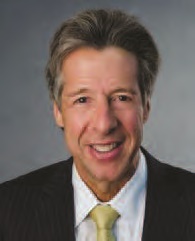 Joel Confino’s specialty is cataract surgery. He is a graduate of the Albert Einstein College of Medicine and completed his Ophthalmology residency at Mount Sinai School of Medicine.
Joel Confino’s specialty is cataract surgery. He is a graduate of the Albert Einstein College of Medicine and completed his Ophthalmology residency at Mount Sinai School of Medicine.
 Erica O’Lenick is a graduate of the Pennsylvania College of Optometry. She has experience in pediatric, binocular vision care, ocular disease, and anterior segment care.
Erica O’Lenick is a graduate of the Pennsylvania College of Optometry. She has experience in pediatric, binocular vision care, ocular disease, and anterior segment care.
Editor’s Note: According to the National Eye Institute, left untreated, dry eye can lead to scarring of the cornea. Some studies have suggested that around 70% of the elderly may suffer from dry eye at one time or another. The condition is especially prevalent in China, where a 2014 article in the Journal of Ophthalmology noted that 17% percent of the population exhibits symptoms.
Trinitas puts the science of “shut-eye” in play.
By Christine Gibbs
Can you recall the moment when you first heard the term sleep hygiene? For those of us who suffer from some form of sleep disorder, the concept couldn’t have come soon enough. From insomnia to sleep apnea, from snoring problems to nodding off at work (or behind the wheel!), the dream of a good night’s sleep is just that—a dream—for upwards of 50 million Americans. Indeed, so much attention has been placed on getting enough sleep in our stress-filled lives that Sleep Medicine is now a recognized medical specialty devoted to the diagnosis and therapy of sleep disorders. For the record, “sleep hygiene” refers to those practices, habits and routines that contribute to a sound sleep.
 According to the American Sleep Association (ASA), nearly one in 10 adults in this country suffers from sleep apnea. Around half have a snoring problem. Two in five adults fall asleep during the day when they should be awake, with an alarmingly high 5% reporting that they do so while driving at least once a month. The ASA also attributes between 3% and 5% of obesity to sleep deprivation. Not surprisingly, insomnia tops the chart of sleep issues.
According to the American Sleep Association (ASA), nearly one in 10 adults in this country suffers from sleep apnea. Around half have a snoring problem. Two in five adults fall asleep during the day when they should be awake, with an alarmingly high 5% reporting that they do so while driving at least once a month. The ASA also attributes between 3% and 5% of obesity to sleep deprivation. Not surprisingly, insomnia tops the chart of sleep issues.
This would explain the growth of the Comprehensive Sleep Disorders Center at Trinitas, which began with a single bed in a single room. It has now expanded six-fold, with four in-hospital beds at the Elizabeth campus and two more located remotely at the Homewood Suites by Hilton in Cranford. The center is accredited by the American Academy of Sleep Medicine.
Dr. Vipin Garg, who has been the program’s director since 2004, focuses on ensuring that everything in the Trinitas Center is as conducive to comfort, personalization, and privacy as possible. This includes ensuite bathrooms, temperature control, TVs, books, and even “get acquainted” visits prior to the first session. He adds that some patients prefer the hotel ambiance to that of the hospital, finding it to be more relaxing and sleep-inducing, adding “we try to make the center less like a hospital and more like a hotel.” Regardless of the venue, the key for all patients, he says, is to relax beforehand.
SERIOUS BUSINESS
Dr. Garg emphasizes the potential seriousness of many underlying causes of sleep problems. “Some disorders such as sleep apnea and insomnia have high mortality rates,” he says. “Even individuals who go to bed late and get up late have a 10% higher mortality rate than average. And of course, sleep deprivation can have disastrous results in the workplace due to diminished cognition and judgment.”
Some of the issues treatable at the center include sleep apnea, insomnia, restless leg syndrome, snoring, and narcolepsy. No issue goes untreated, however, even the non-life threatening ones, such as oversleeping or teeth grinding.
“We are open 24–7, day and night,” he says. “In fact, sometimes we are as much a ‘wake-up’ center as a sleep center.”
Indeed, at times, the Comprehensive Sleep Disorders Center is so successful at inducing sleep that it becomes the only place where patients believe they can get a good night’s rest. In such cases, the patient has to be weaned off dependence on sessions at the center by analyzing the reasons for the preference and recommending reasonable changes to the home environment to make it more sleep-friendly.
 The Sleep Disorders Center is equipped with all state-of-the-art diagnostic equipment to monitor heart, breathing and muscle activity, as well as specialized equipment such as the BiPAP machine, a non-invasive form of therapy for patients suffering from sleep apnea. Videos are an important tool in sleep analysis and are regularly reviewed with patients to help them understand the source of their sleeplessness.
The Sleep Disorders Center is equipped with all state-of-the-art diagnostic equipment to monitor heart, breathing and muscle activity, as well as specialized equipment such as the BiPAP machine, a non-invasive form of therapy for patients suffering from sleep apnea. Videos are an important tool in sleep analysis and are regularly reviewed with patients to help them understand the source of their sleeplessness.
Currently, a staff of 16 mans the Comprehensive Sleep Disorders Center, a 2:1 staff-to-patient ratio. Some are respiratory therapists and others are board-certified polysomnographers. One-on-one supervision is provided to accommodate special needs. On average, 30 patients are seen each week. Males with sleep apnea problems account for the majority; insomniacs are predominantly female. Annually, the center treats about 1,200 patients.
According to Nancy Gonzalez, Chief Technologist, the Comprehensive Sleep Disorders Center is especially proud of its care and support of young sleep-deprived patients. Pediatricians from the surrounding counties frequently refer patients to Trinitas for diagnosis and treatment. Children ranging in age from six months to their teens often present with physical disorders, such as enlarged tonsils/adenoids or sleep apnea. Patients with Down’s syndrome and ADHD have also been treated. In fact, in contrast to most adults, the center’s clinical case studies have revealed that children who are not getting enough sleep at night typically become overactive and agitated during the day, with the unfortunate result that many are misdiagnosed with ADHD.
Along with the very young, many seniors seek solutions at the center for their age-related sleep issues. In general, all patients at the center respond positively to the nurturing staff and comfortable environment. Perhaps the best testament to its reputation is that patients who were treated 10 or 15 years ago, but who suffer a relapse, have confidence enough to return for retreatment.

DOCTOR’S ORDERS
“Sleep disorders of all kinds and of varying degrees are very curable and reversible,” Dr. Garg states. In fact, this positive prognosis was what attracted him to sleep medicine more than 15 years ago. He sums up the center’s treatment protocol as comparable to the recommendations of most healthy diet and exercise programs. Sleep aids are always reserved as a last resort—he indicates that many of the newest drugs are non-addictive and of significant therapeutic value when carefully prescribed and monitored by a physician. As to specific bedtime rituals and requisites, Dr. Garg offers the following suggestions:
- Leave enough time for 7 to 9 hours of sleep.
- Go to bed at the same hour each night.
- Avoid all caffeine or alcohol.
- Keep the room dark and noise-free without distractions such as TV, computer, etc.
- Be sure to visit the bathroom before going to bed.
- Try some deep breathing exercises (but no aerobic exertion for four hours prior to bedtime).
The goal for all patients is to analyze their sleep behavior in order to develop natural and restorative sleep patterns that will improve overall health and add quality to their personal lives.

HOW MUCH IS ENOUGH?
The American Sleep Association has issued the following guidelines for a healthy night’s sleep…
Adult • 7 to 9 hours
Teenager • 8 to 10 hours
Child (6 – 12) • 9 to 12 hours
Child (3 – 5) • 10 to 13 hours*
Child (1 – 2) • 11 to 14 hours*
Infant • 12 to 16 hours*
What’s the right amount of sleep for seniors? It all depends.
* including nap

SENIOR SLEEPERS
Sleep recommendations for seniors are more difficult to generalize since aging often brings on more physical issues, such as restless leg syndrome, acid reflux, and bladder problems that can affect sleep patterns. It is a common misconception that seniors require less sleep; rather, ideal sleep needs remain relatively constant throughout adulthood (with some person-to-person adjustments). Older adults on the whole often have a harder time with their personal sleep architecture—i.e., falling asleep and/or staying asleep. The recommended amount of sleep for seniors, however, remains the same as for most adults: 7 to 9 hours, even when interrupted.
THESE DREAMS
Do dreams come into play in the analysis of sleep disorders? From a scientific perspective, dream content does not determine the quality of sleep —although it can affect the patient’s condition upon waking. Narcoleptics are among the most frequent “day dreamers.” Whether the dreams are sweet or nightmarish, the physical aspects of the sleep event are no different, even though the acting out behavior upon awakening can be dramatically different (for example when based on traumatic real-life events as with many PTSD cases).

Vipin Garg, MD
Director, Trinitas Comprehensive Sleep Disorders Center
908.994.8880
Trinitas branches out to offer convenience and continuity of care.
By Caleb MacLean
If you’ve ever needed to get a simple referral for a special test or treatment, you know that often there is nothing simple about it. Much of the frustration one experiences as a patient in a typical medical practice stems from a lack of communication. In that regard, there is nothing “typical” about the Trinitas Medical Group, where communication, service, and follow-through define the patient experience.
The offices, located in Elizabeth and Clark, are owned by Trinitas, and the physicians and staff are employed by the medical center. In addition to primary care physicians, the Trinitas Medical Group encompasses a wide range of specialty care practices. For the consumer, that translates into a level of convenience that is difficult to find at traditional practices.
“Our primary care patients receive one-on-one personalized treatment and care,” says Nancy DiLiegro, VP of Clinical Operations and Physician Services. “You’re not a number here. Everyone knows you.”
“The sharing of information internally between the practices enables us to interface with the hospital and other services and care providers,” adds Frank Andreola, Director of the Trinitas Medical Group. “So all the paperwork is handled within the practices. If you need one of the ancillary services, we’ll make the call for you and arrange everything. Our staff will make all your appointments for whatever you need.”
Two doctors who have been an integral part of the Trinitas Physicians Practice team are Dr. Vasyl Pidkaminetskiy and Dr. Sergio Baerga. Both appreciate the value of expanding Trinitas’s healthcare services and network of medical professionals beyond the bounds of the flagship hospital in Elizabeth into local communities within Union County. Dr. Pidkaminetskiy (Dr. P to his patients and staff) has worked almost three years in the offices located in Clark, and he is pleased with this unique opportunity to be part of what he calls “a very special group of physicians.”
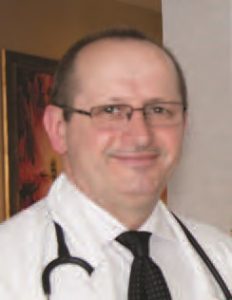 Dr. Pidkaminetskiy is especially impressed with the community-oriented approach of the practice, as well as the convenience of close contact with his colleagues to expedite immediate consultations and sharing of vital patient information. Patients similarly appreciate the wide range of medical services and treatments provided by Trinitas and the ease with which care can be both delivered and accessed at the various practice offices.
Dr. Pidkaminetskiy is especially impressed with the community-oriented approach of the practice, as well as the convenience of close contact with his colleagues to expedite immediate consultations and sharing of vital patient information. Patients similarly appreciate the wide range of medical services and treatments provided by Trinitas and the ease with which care can be both delivered and accessed at the various practice offices.
Everyone in the practice network, he adds, is focused on delivering the best possible care and inspiring the utmost patient confidence.
Dr. Baerga, a surgeon in the Clark office, echoed Dr. P’s sentiments, adding that “the wide variety of clients keeps me on my toes, keeps me thinking and keeps me challenged.”
Ask him how his patients feel about the practice and you’ll get a smile. “I hope they feel okay,” he says. “I think I would hear about it from them if they weren’t pleased about coming here!”
Dr. Baerga also says that he enjoys taking his time and not rushing his patients—something that is emphasized throughout the Medical Group: “I like to get to know them and to learn what’s happening in their lives.”
 Jazmyn Thomas (pictured right), a current patient of the Medical Group, appreciated Dr. Baerga’s kindness before, during, and after having minor surgery. “He was very supportive,” said the Elizabeth resident. “I called him with questions every day, sometimes more than once, and he never made me feel like I was a bother. Even when he wasn’t in the office, he managed to get back to me right away. He made me feel a lot better about everything, especially because I had never had surgery before.”
Jazmyn Thomas (pictured right), a current patient of the Medical Group, appreciated Dr. Baerga’s kindness before, during, and after having minor surgery. “He was very supportive,” said the Elizabeth resident. “I called him with questions every day, sometimes more than once, and he never made me feel like I was a bother. Even when he wasn’t in the office, he managed to get back to me right away. He made me feel a lot better about everything, especially because I had never had surgery before.”
According to Dr. Baerga, as a satellite to the main Trinitas campus, the location of the office in Clark offers the opportunity to meet other professionals in other communities, and to treat a wide variety of clientele— including many of whom speak Spanish. “In fact,” he says, “some days I get to practice so much of my Spanish that I have to remind myself to speak English when I get home.”
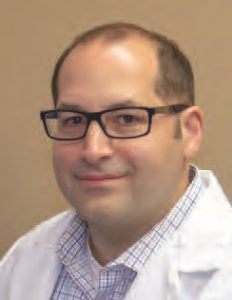
Dr. Sergio Baerga
The list of services includes general surgery, endocrinology, and hematology-oncology and surgery, gastroenterology, ear-nose-throat, breast health, medical oncology, hematology, and radiation oncology, OBGYN and urology.
The availability of doctors for appointments both in Clark and Elizabeth—as well as the availability of specialists— is something that surprises the group’s new patients.
“If your primary care physician wants you to go for a test or be evaluated by a specialist, we can get you in within a week, if not sooner,” says DiLiegro, who adds that another advantage that the Trinitas Medical Group offers is that it accepts any insurance the hospital does, and vice-versa.
“This is a jewel,” says DiLiegro. “We have quality, boardcertified physicians and a multilingual staff providing efficient and timely care in a very difficult landscape where, frankly, a lot of people with good insurance still can’t get to see a practitioner.”
A TEAM EFFORT
 The Trinitas Medical Group offers a large and growing staff of physicians and providers, including…
The Trinitas Medical Group offers a large and growing staff of physicians and providers, including…
Dr. Nazima Abarova, OB/GYN
Dr. Abu Alam, OB/GYN
Traci Alves, NP
Dr. Sergio Baerga, General Surgery
Dr. Gerardo Capo, Oncology/Hematology
Symptom Management
Dr. Michelle A. Cholankeril, Medical Hematology/Oncology
Dr. Ari S. Eckman, Chief, Division of Endocrinology, Diabetes & Metabolism
Dr. Clarissa Febles Henson, Chair, Radiation Oncology
Dr. Clyde T. Jacob, OB/GYN
Dr. Eddy Joseph, OB/GYN
Dr. Rachel Kaye, Otolaryngology/Surgery
Dr. Barry Levinson, Hematology/Oncology
Dr. Prakriti Merchant, Gastroenterology
Dr. Boris Pashkover, Otolaryngology/Surgery
Dr. Jack Perrone, OB/GYN
Dr. Vasyl Pidkaminetskiy, Internal Medicine
Dr. Mark Preston, OB/GYN
Dr. Vincent Salerno, Hematology/Oncology
Dr. Adriana Suarez-Ligon, General Surgery
Dr. Richard Tai, OB/GYN
Dr. Oscar Verzosa, Internal Medicine
Dr. Michael Viksjo, Gastroenterology
Midwives:
Carol Rose Trzaska, CNM
Shirley McDuffie, CNM
Chantal Berry, CNM
MaryBeth Weimer, CNM
Editor’s Note: For more information on the Trinitas Medical Group, visit TrinitasMedical.Group or call (732) 499-9160. The Clark Office is located at 67 Westfield Avenue.

And what a character he is. Kenneth Hari is a unique blend of master artist, sculptor, art historian, man-about-the world, and speeding comet. His work hangs in 350 museums worldwide (including the Vatican’s) and his portrait subjects read like a Who’s Who of cultural icons, including Salvador Dali, Ernest Hemingway, Greta Garbo, Marcel Marceau, Helen Keller, James Earl Jones, Gene Kelly, Aaron Copeland, Lauren Bacall, Pablo Casals, Otto Preminger, Isaac Asimov and W.H. Auden, to whom Hari was like a godson. After a lifetime of travel, he now works out of his home in Hopelawn…where his wife, Xiaoyi Liu, cannot (and would not) quiet his talented hand.

Elie Wiesel, 24” x 30”, drawing

Twins, 20″x24″ drawing
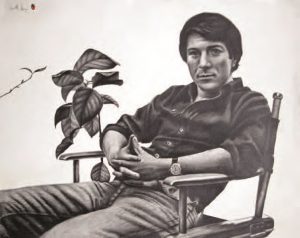
Dustin Hoffman, 24″x30″ drawing

Jacqueline, 20″x24″ drawing

Sitarist Ravi Shankar, 24″x30″ drawing

Future Generations, 11″x14″ drawing

Concealment of Erotic Emotion, 24″x30″

James “Amazing” Randi, 24″x30″ drawing

Self-Portrait, age 14, 8″x10″ oil painting

Cynthia, 30″x40″ oil painting

Cynthia and Christopher, 11″x14″ drawing

Christopher, 11″x14″ drawing

Poet Marianne Moore, 20″x24″ drawing
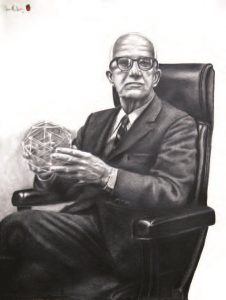
Architect Buckminster Fuller, 24″x30″

Hari with The Pearl Earring, 24″x30″ oil painting
Editor’s Note: Special thanks to Tova Navarra, author of the indispensable New Jersey Artists Through Time and the upcoming New Jersey Masters: A Legacy of Visual Arts, in which Kenneth Hari is featured. Hari was born in Perth Amboy, the original epicenter of American Art beginning with portraitist John Watson’s immigration from Scotland to the fledgling colony in 1715. Hari’s father was a drummer in a band, so the family moved frequently; in California he was a classmate of Dustin Hoffman’s and in Key West swam in Tennessee Williams’s pool. A graduate of the Newark School of Fine and Industrial Arts, Hari earned a BFA from the Maryland Institute College of Art and also worked and studied at Yale and NYU.
Yeah We grow ‘em strong in the Garden State.
By Christine Gibbs
Though it may not always look it, being a teenager these days is some hard work. True, the physical strain of socializing has been diminished by the advent of smartphones, and window-shopping can now be done online, but all that connectivity also means you are tethered to technology and accountable to your peers 24 hours a day. And while it’s never been easier to speak up and stand out, in some respects it’s never been more difficult. The virtual space is getting more and more crowded for young people who want to embrace activism or self-advocacy, and there is a seemingly limitless amount of video on the athletically and artistically talented. And yet, as we witnessed with March for Our Lives, the student-led demonstration in Washington this spring, the cream of the teenage crop always finds its way to the top.
New Jersey has a long history of “terrific teens”—in science, sports, the arts and, more and more, in politics and social movements. Here are 10 (well, technically, 11) we think are worth keeping an eye on…

Ziad Ahmed
Ziad, an 18-year old Bangladeshi-American Muslim who is a self-described “activist, public speaker and college student,” hails from Princeton. In 2013, as a high-school freshman, he founded an anti-discrimination organization called Redefy, which defines its mission as “the belief that all hate stems from ignorance and that, through conversation and education, acceptance will prevail.” Ziad has attracted hundreds of students internationally to join the Redefy team. In 2017, he made headlines nationally when he was accepted at Stanford University by writing #BlackLivesMatter 100 times as his essay (although he ultimately chose to attend Yale, where he remains politically and culturally active). Ziad’s many credits include being named a 2017 Global Teen Leader and a High School Trailblazer by MTV, as well as being included among the Business Insider Top 15 Young Prodigies Changing the World. He is a Diana Award winner and a recipient of the Princeton Prize in Race Relations, and has appeared on NBC, BBC and Bloomberg Businessweek. Ziad has been a guest at the White House three times and was personally commended by Barack Obama for his commitment to improving race relations.

Courtesy of Autumn de Forest
Autumn de Forest
Autumn’s roots go deep into her hometown of Stone Harbor, beginning with her first exhibit at Ocean Galleries at age 10. Having spent more than half her young life in pursuit of her art, she has been called “one of the most important artists of her generation” by the Walt Disney Company and “a creative genius” by the Discovery Channel. Her imaginative style has often resulted in her being labeled as an abstract artist—prompting comparison of her work at an early age to masters such as Warhol, Pollock, and Picasso. Autumn made history two years ago as the youngest artist to be exhibited at the prestigious Butler Institute of American Art. Yet her work, which often commands commissions in the six figures, has the unique added dimension of reflecting her dedication to helping others through art. She supports numerous charities, including the Red Cross, Habitat for Humanity and This Bar Saves Lives (a gluten-free snack bar whose proceeds go to help feed hungry children). Her talent, coupled with her humanitarianism, brought her to the attention of the Vatican in 2016, where she was granted a private audience with Pope Francis—at which time she had the opportunity to present him with a special gift of a painting entitled Resurrection.

YouTube
Ethan and Grayson Dolan
Known by their enthusiastic fans as The Dolan Twins, Ethan and Grayson are a comedy duo from Washington Township in Morris County. They catapulted into social media stardom and, two years ago at age 16, they surpassed 2 million followers on their YouTube channel— by posting video skits of their larger-than-life lives as teenage twins. Since then, Ethan and Grayson have accumulated more than 5 million followers on YouTube and 6 million on Twitter, and launched a nationwide variety-show tour. You can also catch them as correspondents on MTV. If you want to know what cutting-edge “content creators” look like in this day and age, search for TheDolanTwins on YouTube.

Alex Jackman
August 2nd is World Autism Awareness Day, sponsored by the United Nations. No one is more worthy of recognition as a long-time advocate on behalf of those afflicted with autism than Alexandra Jackman. In 2014, as a freshman at Westfield High School, she wrote and directed the award-winning video, A Teen’s Guide to Understanding and Communicating with People with Autism, which won awards at film festivals throughout the country. In 2016, as a junior, Alex was honored with a Choice Changemaker Award and also a Point of Light Award for her volunteerism in orchestrating special events for teens with special needs. She is an ardent advocate whose mantra is “People are worth the effort!” Alex’s activism does not stop with autism; she also is involved in many anti-bullying campaigns and worked with the Autism Center at Montclair State University to create a curriculum to accompany her film before it was distributed to students internationally. She has authored articles for the Huffington Post among others and managed to find the time to serve as student body president. Alex also founded the Hang Out Club, which promotes inclusivity and embraces special needs students.

The Food Network
Linsey Lam
This past March, 13-year-old Linsey took home the$25,000 prize as the winner of Food Network’s Kid’s Baking Championship. Her appearance competing against a dozen other young chefs was the culmination of years binging on the network’s baking shows in her Closter home. Linsey’s favorite part of baking cakes is creative frosting. The bigger the cake, the better to show off her talents. The show’s dessert challenges—from dessert pizzas to desserts fit for an astronaut—brought out the best in Linsey over a 10-episode arc and made her hands-down the most impressive and creative kid baker in the country.

NBC/Chris Haston
Wé McDonald
The Paterson teen placed third on NBC’s The Voice last season, attracting as a mentor Alicia Keys. In Wé’s appearances on the program, she entranced millions of viewers each week, rocketing her to the top of the iTunes charts multiple times. Although the experience was intimidating at times, Wé managed to hold her own despite being the youngest performer among the Final Four—and the only female of color (as she is quick to point out). Her rendition of Mary J. Blige’s “No More Drama” has been viewed more than 3.5 million times on YouTube.

JRotondo1410
Sydney McLaughlin
Sydney McLaughlin was cited by Time as one of its 30 Most Influential Teens of 2017. A hurdler and sprinter from Dunellen—who now competes for the University of Kentucky—she holds several world titles for her age group and was named Gatorade National Girls Athlete of the Year for both 2015–16 and 2016–17. As if these accolades were are not enough, Sydney placed third in the 400-meter hurdles at the 2016 United States Olympic Trials, qualifying for the 2016 Summer Games in Rio. There she became the youngest U.S. track and field Olympian since 1972 to reach the semifinals of the 400-meter hurdles

Courtesy of NYO Dancers
Brooke Rotondo
Brooke is a dedicated performer who has earned high marks in the performing arts as a dancer, model and actress. Last year, at age 15, the Middletown North High School sophomore was selected as a back-up dancer for the Disney star Meredith O’Connor. As a member of the dance group, Brooke performed and modeled at New York Fashion Week, proudly wearing the “Warrior” collection designed by Janelle Funari. Brooke also was a special performing artist at the Carol Galvin Foundation Gala during Fashion Week. At 16, Brooke has been dancing for more than 12 years and excels at hip hop, tap, jazz, modern, and also performs in lyrical and musical theater. She is currently studying ballet with Not Your Ordinary Dancers in Middletown.
Michelle Sidor
NorthJersey.com called Michelle “North Jersey’s most coveted athlete” as she started her junior year at Saddle River Day School last fall. A cat-quick sharpshooter who isn’t afraid to mix it up in the paint, she became the first Bergen County junior to reach the 2,000-point plateau. With her senior season still ahead, Michelle has already cracked the state’s all-time Top 10 scoring list. Look for her to make headlines in 2019–20 as the freshman star for a major college hoops program.

Rob Davidson
Matthew Whitaker
Born blind, Matthew began playing piano at the age of three in 2004 on a small Yamaha keyboard in his Hackensack home. Six years later his status as a keyboard prodigy was confirmed when he won Amateur Night at the Apollo. At age 13, Matthew became the youngest talent to be endorsed by the Hammond Organ Company and, at 15, was honored by Yamaha as its youngest Yamaha Piano Artist. Matthew has already made concert appearances at Lincoln Center, Carnegie Hall, the John F. Kennedy Center and The Youth Assembly at the United Nations. His international concerts have taken him to Europe, the Middle East and Asia. Last year, at age 16, he performed on the organ at the 35th Annual McDonald’s Gospelfest at the Prudential Center in Newark. Of course, Matthew can still be found behind the organ of the New Hope Baptist Church in his hometown.
Editor’s Note: Teen power is hardly a modern phenomenon in New Jersey. Trenton’s Edith Mae Savage-Jennings, who passed away last year at the age of 93, met First Lady Eleanor Roosevelt and became her pen pal at age 10. Two years later, Edith joined the NAACP as its youngest member. She helped to integrate the Capital Theater in Trenton by refusing to sit in the “blacks-only” balcony when she was 13 and went on to work alongside Dr. Martin Luther King.
EDGE takes you inside the area’s most creative kitchens.

Paragon Tap & Table • Beef Ramen
77 Central Ave. • CLARK
(732) 931-1776 • paragonnj.com
As we constantly introduce new flavors from around the world to our customers at Paragon Tap and Table we have added an Asian inspired Noodle Dish with a touch of the south. Our beef ramen noodle showcases all the characteristics of a traditional ramen but twisted with the smokiness of the smoked beef brisket.
— Eric B. LeVine, Chef/Partner

Arirang Hibachi Steakhouse • Wasabi Crusted Filet Mignon
1230 Route 22 West • MOUNTAINSIDE
(908) 518-9733 • partyonthegrill.com
We prepare a crusted 8-ounce filet mignon served with gingered spinach, shitake mushrooms, and a tempura onion ring.

Daimatsu • Sushi Pizza
860 Mountain Ave. • MOUNTAINSIDE
(908) 233-7888 • daimatsusushibar.com
This original dish has been our signature appetizer for over 20 years. Crispy seasoned sushi rice topped with homemade spicy mayo, marinated tuna, finely chopped onion, scallion, masago caviar, and ginger. Our customers always come back wanting more.
— Chef Momo

The Barge • Cioppino
201 Front Street • PERTH AMBOY
(732) 442-3000 • thebarge.com
Our Cioppino, the signature dish of San Francisco, features a fresh, healthy selection of clams, mussels, shrimp, Maine lobster and Jersey scallops—drizzled in Greek virgin olive oil, with fresh garlic and white wine—over homemade Italian linguini. I know it will become one of your favorite dishes.
— Alex Vosinas Chef/Owner

Luciano’s Ristorante & Lounge • Warm Goat Cheese Salad
1579 Main Street • RAHWAY
(732) 815-1200 • lucianosristorante.com
The warm goat cheese salad with tender greens and a mulled cabernet dressing and toasted pine nuts is a signature appetizer at Luciano’s, where fresh ingredients and personable service in a beautiful Tuscan décor create a fine dining experience. Our menus are seasonally influenced to feature the best of what’s available in the market.
— Joseph Mastrella, Executive Chef/Partner

Morris Tap & Grill • The Monster Burger
500 Route 10 West • RANDOLPH
(973) 891-1776 • morristapandgrill.com
As the leader in the gastropub world in New Jersey, Morris Tap and grill has been providing creative, quality, fresh certified burgers for over 6 years. Here’s an example of what we do creatively with our burgers, The Monster Burger. Two certified angus beef burgers topped with chorizo sausage, slaw, bacon, cheddar cheese and a fried egg!
— Eric B. LeVine, Chef/Partner

Garden Grille • Grilled Chicken Paillard
304 Route 22 West • SPRINGFIELD
(973) 232-5300 • hgispringfield.hgi.com
Grilled chicken paillard with roasted corn, asparagus, cauliflower, baby arugula and grape tomato, extra virgin olive oil & aged balsamic.
— Chef Sean Cznadel

LongHorn Steakhouse • Outlaw Ribeye
272 Route 22 West • SPRINGFIELD
(973) 315-2049 • longhornsteakhouse.com
LongHorn Steakhouse has opened in Springfield, and we are looking forward to meeting all of our future guests! When you visit us, we suggest you try our fresh, never frozen, 18 oz. bone-in Outlaw Ribeye—featuring juicy marbling that is perfectly seasoned and fire-grilled by our expert Grill Masters.
— Anthony Levy, Managing Partner

Outback Steakhouse • Bone-In Natural Cut Ribeye
901 Mountain Avenue • SPRINGFIELD
(973) 467-9095 • outback.com/locations/nj/springfield
This is the entire staff’s favorite, guests rave about. Bone-in and extra marbled for maximum tenderness, juicy and savory. Seasoned and wood-fired grilled over oak.
— Duff Regan, Managing Partner

Arirang Hibachi Steakhouse • Volcano Roll
23A Nelson Avenue • STATEN ISLAND, NY
(718) 966-9600 • partyonthegrill.com
Hot-out-of-the-oven, crab, avocado and cream cheese rolled up and topped with a mild spicy scallop salad.

Ursino Steakhouse & Tavern • House Carved 16oz New York Strip Steak 1075 Morris Avenue • UNION
(908) 977-9699 • ursinosteakhouse.com
Be it a sizzling filet in the steakhouse or our signature burger in the tavern upstairs, Ursino is sure to please the most selective palates. Our carefully composed menus feature fresh, seasonal ingredients and reflect the passion we put into each and every meal we serve.
When drugs won’t work for depression, what’s the next move?
By Yolanda Navarra Fleming
According to the Centers for Disease Control, 1 in 30 people in America will deal with major depression this year. The prevalence of major depressive episodes increases with age, with the rate climbing to 1 in 20 for people between the ages of 46 and 64. Over 65, the number of severe cases declines, but about 10 percent of American adults over 65 will develop what could be considered “mild depression”—which is a gentle way of saying it’s a diagnosable depressive disorder.
Overall, women are at least 50 percent more likely to report a significant depressive episode. Roughly 11 percent of adolescents will deal with a depressive disorder by the age of 18, while 30 percent of college students report that they felt sad or depressed to the degree that it affected their ability to function in school.
 You can quibble with these numbers—they rise and fall depending on clinical criteria and also who’s doing the studies—but there is no arguing that depression has a crippling effect on almost every aspect of the pursuit of happiness in America. On one end of the spectrum, it may involve temporary sadness (aka “the blues”). On the other end, it can last indefinitely, profoundly diminishing quality of life to the point of complete dysfunction. According to the Anxiety and Depression Association of America, depression is the leading cause of disability worldwide. People with depression may also suffer from anxiety disorders, which are different, but share similar symptoms—including insomnia, the inability to concentrate, nervousness, and irritability.
You can quibble with these numbers—they rise and fall depending on clinical criteria and also who’s doing the studies—but there is no arguing that depression has a crippling effect on almost every aspect of the pursuit of happiness in America. On one end of the spectrum, it may involve temporary sadness (aka “the blues”). On the other end, it can last indefinitely, profoundly diminishing quality of life to the point of complete dysfunction. According to the Anxiety and Depression Association of America, depression is the leading cause of disability worldwide. People with depression may also suffer from anxiety disorders, which are different, but share similar symptoms—including insomnia, the inability to concentrate, nervousness, and irritability.
 The good news is that doctors have an ever-growing arsenal of pharmaceutical solutions. These medications have changed the game for millions of sufferers. The not so- good news is that a high percentage of individuals—as many as half of the 15 million people experiencing depression—either cannot tolerate or do not respond to these drugs.
The good news is that doctors have an ever-growing arsenal of pharmaceutical solutions. These medications have changed the game for millions of sufferers. The not so- good news is that a high percentage of individuals—as many as half of the 15 million people experiencing depression—either cannot tolerate or do not respond to these drugs.
Enter Transcranial Magnetic Stimulation (TMS), an FDA cleared non-invasive treatment that uses magnetic fields similar to an MRI to stimulate the brain. The treatment has no systemic side effects and requires no hospitalization or anesthesia. To date, the therapy has been proven in more than 60 clinical trials worldwide.
The Trinitas-St. Joseph’s Behavioral Health Network has partnered with HPR Treatment Centers (a division of TMS Centers of America) to offer BrainsWay Deep TMS at two treatment facilities in Essex County, followed by another six sites throughout Northern New Jersey over the next year.
Despite being a newer treatment for depression, TMS is a proven option with impressive efficacy rates and research results.
“TMS is indicated for the treatment of adults with major depression who have not responded to at least one antidepressant,” says Dr. Carlos Rueda, Chairman of Psychiatry for the Trinitas-St. Joseph’s Behavioral Health Network. “We are excited to bring this therapy option to the residents of New Jersey, offering new hope for a complex condition.”
“This partnership allows us to work with two of the leading medical institutions in the state to provide a comprehensive continuum of care to treat those suffering from depression,” adds Ben Klein, Founder and CEO of HPR Treatment Centers. “We have been offering TMS to patients across the country and know firsthand the significant impact the treatment has on patients. We have seen people with depression—who have lost hope— regain it when they achieve remission through TMS.”
“Depression is believed to be caused by electrical dysfunction of one region of the brain, known as the dorsolateral prefrontal cortex,” explains Dr. Rueda. “Through a highly focused and targeted magnetic stimulation, we’re able to boost the function of the brain in this region, allowing for a remission of the depression.” Because TMS is a non-drug, non-invasive treatment, patients are awake during the procedure and can get back to daily activities, including driving, immediately following the session.
“We look forward to working with HPR Treatment Centers to help Trinitas and St. Joseph’s deliver optimal mental health solutions to their patients and partner with them in this initiative that will address a growing challenge in treating mental health patients,” says Joe Perekupka, Vice President at BrainsWay. “HPR Treatment Centers have demonstrated true leadership in increasing access to Deep TMS for patients across the country. By providing the tools necessary to help these facilities treat patients who are suffering from mental disorders, we are enabling better outcomes for patients.”
Trinitas Expands Behavioral Services to Bayonne
 Elizabeth-based Medical Center assumes ownership of Bayonne Community Mental Health Center The healthcare world is in a rapid state of transformation where new opportunities often arise to elevate the level of care. Such an opportunity presented itself in 2017, when the Board of Trustees of Bayonne Community Mental Health Center (CMHC) elected to have Trinitas Regional Medical Center assume ownership of the CMHC. “This transition to ownership by Trinitas promises to be as seamless as possible. There are no plans for any interruption or major changes in the name, services, personnel, hours, location or anything else that would impact the clientele or the community,” explained Joseph M. Kadian, Psy.D., President and CEO of the CMHC.
Elizabeth-based Medical Center assumes ownership of Bayonne Community Mental Health Center The healthcare world is in a rapid state of transformation where new opportunities often arise to elevate the level of care. Such an opportunity presented itself in 2017, when the Board of Trustees of Bayonne Community Mental Health Center (CMHC) elected to have Trinitas Regional Medical Center assume ownership of the CMHC. “This transition to ownership by Trinitas promises to be as seamless as possible. There are no plans for any interruption or major changes in the name, services, personnel, hours, location or anything else that would impact the clientele or the community,” explained Joseph M. Kadian, Psy.D., President and CEO of the CMHC.
According to Gary S. Horan, FACHE, President & CEO of Trinitas, “In line with Trinitas’ historically strong leadership role in mental health and substance abuse treatment, the Bayonne community can expect to receive the highest level of care it has come to know and rely on during the span of the Center’s 46 years of service. Trinitas plans to upgrade important elements of administration, including electronic medical records, computerized registration and billing software, and high-speed telecommunications equipment.”
Questions can be directed to Dr. James McCreath at 908-994-7060 jmcreath@trinitas.org.
THE ROOTS OF TMS
 The field of Electrophysiology (of which Transcranial Magnetic Stimulation is a part) is nothing new. In fact, it dates back centuries. Near the end of the 18th century, Luigi Galvani first performed the same experiment you probably did in high-school Biology: noting that the legs of a dead frog twitched when touch by an electrical current. Galvani’s name is still with us today (galvanization). Several decades later, another giant in the history of science, Michael Faraday, did groundbreaking work in electromagnetism and electrochemistry, which established the foundation for research on brain stimulation through electricity and magnetism. By the mid-1900s, electroconvulsive therapy was widely used to treat major depression and other forms of mental illness. The first use of magnetic fields on electric signaling in the brain began in the 1980s, primarily for diagnostic purposes. By the early 2000s, however, researchers started noting the therapeutic possibilities of TMS.
The field of Electrophysiology (of which Transcranial Magnetic Stimulation is a part) is nothing new. In fact, it dates back centuries. Near the end of the 18th century, Luigi Galvani first performed the same experiment you probably did in high-school Biology: noting that the legs of a dead frog twitched when touch by an electrical current. Galvani’s name is still with us today (galvanization). Several decades later, another giant in the history of science, Michael Faraday, did groundbreaking work in electromagnetism and electrochemistry, which established the foundation for research on brain stimulation through electricity and magnetism. By the mid-1900s, electroconvulsive therapy was widely used to treat major depression and other forms of mental illness. The first use of magnetic fields on electric signaling in the brain began in the 1980s, primarily for diagnostic purposes. By the early 2000s, however, researchers started noting the therapeutic possibilities of TMS.
Editor’s Note: BrainsWay Deep TMS was developed in collaboration with the National Institute of Health (NIH) and is FDA and CE cleared to treat patients with depression who are not currently responding to medication. The treatment is widely covered by most insurance payers. For more information or to make an appointment, call (631) 807-5759.
What can you say about a standup comic who heckles himself? In the case of Jim Gaffigan, you can’t say enough. His observational comedy on the challenges of parenting, horrendous eating habits, and his own laziness has made him the most American of American comics. Professionally, Gaffigan is living the dream. He has conquered every platform a comedy icon can: television, film, radio, large venue, small venue, voiceover, publishing, CDs, DVDs, writing, directing and producing. He even earned rave reviews on Broadway in That Championship Season. Gaffigan, who received his third Best Comedy Album Grammy nomination this year for Cinco, will be making a stop in the Garden State this summer on his Fixer Upper Tour, with two shows scheduled for The Borgata in Atlantic City on August 4. Jim Sawyer caught Jim between gigs a few days before the tour began.
EDGE: Is there such a thing as a “New Jersey audience?”
JG: New Jersey is three different worlds. And I’m sure it’s more than that. There’s Northern New Jersey, which is the suburb of New York, and there’s South Jersey, which is decidedly influenced by Philly. And then there’s the Jersey Shore.
EDGE: What do they have in common?
JG: You know, there is something about the Northeast. I chose to live in the northeast—I talk about this in my new special. What I love about Jersey is that it has this Northeast anger and passion, where, if you don’t deliver they’re going to throw you out. Yet Jersey also has this quality of “being taken on” by other states in the Northeast. I’m from one of those states, Indiana, which has to deal with being the butt of other cities’ jokes. So there’s a similar underdog quality that translates to a certain amount of pride.
EDGE: Do you set aside specific time for writing or do you jot down ideas as they come to you and develop them when you can?
JG: You know it’s always changing. Sometimes it is jotting down things on my iPhone and kind of fooling around. I wish it was more like that. But, sometimes it’s, you know, 20 minutes before a show talking to my friend who works with me on the show and I’m just coming up with an idea. Yeah, so I wish I could figure out where it all comes from because I’d go to that mind a lot more. But, in the end, there is nothing more rewarding than coming up with a new joke, or a new chunk, a topic.
EDGE: When you have reached the top of the comedy business- which you have- you have to think a lot more about the “business of comedy.” How has your business model changed over the years, and where do you see it evolving in the future?
JG: I think standup comedy, over the time that I’ve done it, has changed so dramatically in just accessibility to the public. And it’s changed from you get five minutes, and you try to get on the Tonight Show to you provide hour specials and they’re consumed on different platforms. My journey has changed so much. But I love writing new hours of material and finding myself getting better at standup.
EDGE: Is that a constant challenge?
JG: It’s all about self-refinement, right? So I don’t know. I love standup so much and it’s something I feel like I’m getting better at. So I like where it’s heading and, who knows, it’s like, in five years it will be a completely different business. When I did Beyond The Pale on Comedy Central that’s probably one of the more impactful things that happened in my career. But, in the next 10 years, there will probably be two other things that are the equivalent of YouTube or Netflix or satellite radio. Things just really keep changing and making standup more accessible to the world frankly.
EDGE: What are the parenting challenges that are peculiar to your particular profession?
JG: I think the unique one is probably balancing travel. I mean I’ve made a point of traveling as much as I can with my kids. You know, you forgo kind of making money on some trips, but I wouldn’t do it any other way. And I think the other thing is as a comedian, by necessity, you have to peak at night. Whereas parenting, it’s a 24-hour job.
EDGE: What for you is the most important part?
JG: I think the morning is a very important job. When I get the opportunity to go to school with my kids or drop them off…I wish I could do that more often. But, if I’m flying in from doing a show and I get home at 1:00 a.m., it’s unlikely that I’m going to be able to get up and make them eggs.
EDGE: You’ll be at The Borgata this summer. Casino crowds traditionally have been different than theater and club crowds. Do you find that’s still the case?
JG: It used to be much more the case. But now, you know, whether it’s The Borgata or Vegas, I think people are there for the shows. It’s kind of changed dramatically—just as performing at colleges has changed dramatically. Obviously, the casinos want people to stick around. But a lot of the venues in casinos are just so beautiful, they’re the best in the area, just great venues.
THE GAFFIGAN FILE
Born: July 7, 1966
Birthplace: Chesterton, Indiana
College: Georgetown Class of 1988
Residence: New York City
Fun Facts
- At the age of five, Jim announced that he wanted to grow up to be “an actress.”
- Jim was a football star in high school and played varsity ball in college.
- Jim took a comedy class after moving to New York in the late 1980s and fell in love with standup.
- His beloved Hot Pockets routine was inspired by an actual commercial that he mistook for a Saturday Night Live sketch.
- Jim is one of several actors who have played Colonel Sanders in KFC’s popular TV ad campaign.
- Jim’s acting skills have earned him guest appearances on some of TV’s most popular comedies, including Portlandia, That 70s Show, Sex and the City, Bored to Death and Unbreakable Kimmy Schmidt.
- His own series, The Jim Gaffigan Show, ran for two seasons on TV Land.
- Jim won an Emmy in 2015 for his contributions to CBS Sunday Morning.
- Jim played attorney Paul Markham in the 2018 film Chappaquiddick.
Editor’s Note: Although no one would call Jim Gaffigan a visionary, in 2005’s Beyond the Pale, he did correctly predict that Dunkin Donuts would one day unveil a glazed donut breakfast sandwich. Of course, he meant it as a joke.












